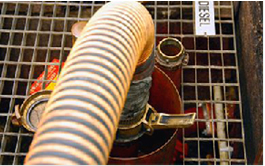 |
Tank Deferrals
Emergency power generators. UST systems storing fuel for use by emergency power generators are deferred from release detection requirements. However, the proposed UST rules remove the deferral and require these UST owners and operators to perform release detection within one year of the effective date of the final rules.
The 1988 UST regulations deferred emergency generator tanks because technology was not available to monitor remote sites. The technology is now available to monitor and detect releases. These systems have releases similar to other regulated UST systems and need to have release detection monitoring.
Now is the time to determine if you are in compliance with the most recent UST regulations! Join us for an in-depth webinar on July 29. Learn More
Wastewater treatment tanks. In addition, the 1988 UST regulations deferred wastewater treatment tanks because of uncertainty of some release detection methods for these systems. EPA believes there are no active systems to which this regulatory requirement will apply. However, if any of these systems do exist, release detection and prevention technologies are available for these systems to prevent and quickly detect releases to the environment.
Field-constructed tanks (FCT) and airport hydrant systems (AHS). EPA’s proposed regulations also remove the deferral for FCT and AHS, but continue to defer aboveground tanks associated with FCT and AHS. The 1988 regulations deferred AHSs and FCTs because sufficient information and technology was not readily available for these unique systems. Technology is now available to monitor and detect releases at alternative leak rates and frequencies.
Release Prevention and Detection
Flow restrictors. USTs may use flow restrictors in vent lines (also called ball float valves) to meet the overfill prevention equipment requirement. This technology has several inherent weaknesses and can result in tanks being over pressurized. The proposed rules eliminate flow restrictors in vent lines as an option for owners and operators to meet the overfill prevention equipment requirement for newly installed UST systems and when flow restrictors in vent lines are replaced.
Internal lining. EPA’s proposed rules require that UST owners and operators must permanently close tanks using internal lining as the sole method of corrosion protection, if the internal lining fails the periodic inspection and cannot be repaired according to a code of practice. The 1988 regulations allowed lining as an upgrade option to extend the life of some tanks. While linings extended the life of many tanks, this is not a permanent solution. As the tank linings fail, these older tanks must be taken out of service to prevent releases to the environment.
Get the latest updates on the recent 2012 UST regulatory changes and learn effective strategies for complying with those requirements. Join us for an in-depth UST webinar on July 29. Register Now
Codes of Practice
The 1988 UST regulations require UST systems to be compatible with the material stored in them. Two codes of practice are referenced in a note. The proposed rule change does not alter that, but rather helps owners demonstrate compatibility with their system. As newer fuels enter the market place, it is even more important for owners and operators to clearly understand how to demonstrate compatibility with these fuels and ensure there are no releases to the environment due to stores fuels being incompatible with UST systems.
 |
EPA’s proposed rules include the following:
- Owners and operators to demonstrate compatibility for UST systems storing greater than 10 percent ethanol or greater than 20 percent biodiesel, or any other regulated substance the regulatory agency identifies, by one of these methods:
- Listing by a nationally recognized independent testing laboratory
- Equipment or component manufacturer approval
- Another method the regulatory agency determines to be no less protective of human health and the environment than the other methods
- Owners and operators to maintain compatibility records for the life of the equipment or component for all new or replace equipment and for UST systems storing greater than10 percent ethanol or greater than 20 percent biodiesel
- EPA removes references to the two codes of practice.
- EPA revises definitions of motor fuel and regulated substance.
State Program Approval
EPA plans to update state program approval requirements to implement delivery prohibition, operator training, and additional measures to protect groundwater requirements contained in the EPAct of 2005. These proposed changes ensure states will also update their programs with the increased environmental protections. It provides consistency between federal and state UST regulations. States with program approval will have 3 years to submit a revised state program approval package.
Resources:
- Comparison of 1988 UST Regulations and Proposed UST Regulations (October 2011) (Document 138745)
- Federal Register Notice – Proposed UST Regulations (November 18, 2011)
